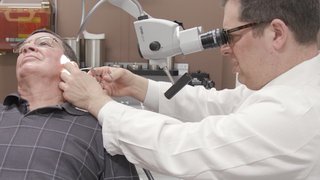About Acoustic Neuromas
An acoustic neuroma is a benign (nonmalignant) tumor that originates on the nerves affecting hearing or balance. These nerves are located deep in the skull and are very close to other important structures.
Because the tumor involves these particular nerves, patients usually experience hearing loss, ringing in the ear, or problems with balance. Larger tumors can cause facial numbness, headaches, and the accumulation of fluid around the brain that can be fatal if left untreated.
Diagnosis and Evaluation
When a patient is seen at UT Southwestern for a possible acoustic neuroma, the evaluating physician will gather information about the size and shape of the tumor, the current level of hearing, and any previous treatments. We then confer with the multidisciplinary acoustic neuroma team, and together we will formulate a personalized treatment plan.
All patients with acoustic neuromas are seen promptly. Same- and next-day appointments are often available.
Treatment for Acoustic Neuromas
Treating acoustic neuromas can be complex because of the anatomy and other individual factors involved. At UT Southwestern, we use a multidisciplinary approach involving a neurotologist (specialist in neurological disorders of the ear), a neurosurgeon, and, when appropriate, a radiation oncologist for the best possible outcomes. Treatments include observation, radiosurgery (radiation therapy), and surgery.
Observation
Small tumors and some medium tumors can be observed with regular MRIs. If initial scans do not show tumor growth, an annual MRI is usually then required to ensure there’s no further development. If initial scans show the tumor has grown, further treatment is indicated.
Observation is not recommended for young patients or patients with large tumors. Hearing loss is possible during the observation period and can be sudden in some cases.
Radiosurgery
Radiosurgery is the precise use of radiation with the goal of stopping tumor growth. Generally, the tumor should show signs of growth via multiple MRIs before the tumor is treated with radiosurgery.
The procedure is performed on an outpatient basis and is well tolerated, although some patients experience temporary headache and nausea.
The risks of radiosurgery include continued tumor growth, facial numbness, hearing loss, dizziness, ringing in the ear, facial paralysis or twitching (rare), and fluid buildup around the brain.
If the tumor needs to be removed after radiosurgery because of continued tumor growth, complications (such as facial weakness) tend to be more common. Also, there is a small risk of the tumor turning malignant (cancerous), estimated to be 1 in 1,000 cases over a 30-year period.









